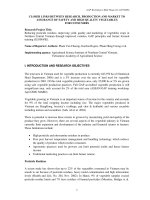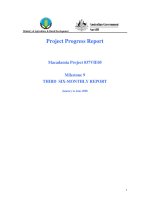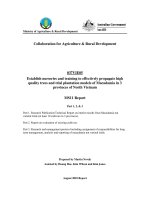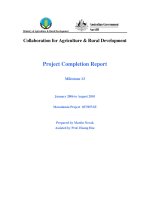Establish nurseries and training to effectively propagate high quality trees and trial plantation models of Macadamia in 3 provinces of North Vietnam - MS2 " pdf
Bạn đang xem bản rút gọn của tài liệu. Xem và tải ngay bản đầy đủ của tài liệu tại đây (133.29 KB, 9 trang )
260
Ministry of Agriculture & Rural Development
CARD Project Progress Report
037/05VIE
Establish nurseries and training to effectively
propagate high quality trees and trial plantation
models of Macadamia in 3 provinces
of North Vietnam
MS2: FIRST SIX-MONTHLY REPORT
August 2006
1
1. Institute Information
Project Name
Establish nurseries and training to
effectively propagate high quality trees
and trial plantation models of
Macadamia in 3 provinces of North
Vietnam
Vietnamese Institution
Center for Environment, Tourism and
Development (CETD),
Vietnamese Project Team Leader
Prof Hoang Hoe
Australian Organisation
Subtropical Farm Forestry Association
Australian Personnel
Martin Novak, Kim Wilson
Date commenced
10 January 2006
Completion date (original)
10 January 2009
Completion date (revised)
Reporting period
First 6 months
Contact Officer(s)
In Australia: Team Leader
Name:
Martin Novak
Telephone:
61 2 66895027
Position:
President
Fax:
61 2 66895227
Organisation
Subtropical Farm Forestry
Association
Email:
In Australia: Administrative contact
Name:
Valda Mitchell
Telephone:
61 2 66284372
Position:
Administrative Officer
Fax:
61 2 66284386
Organisation
Subtropical Farm Forestry
Association
Email:
In Vietnam
Name:
Hoang Hoe
Telephone:
04 8642670, 04
7560233
Position:
Director
Fax:
04 7560233
Organisation
CETD
Email:
2
2. Project Abstract
This project has commenced to establish a new Macadamia nursery and enhance three existing nurseries.
Also 3 variety trials of Macadamias have been designed, of about 1 ha each involving 14 suitable
Macadamias varieties, in 3 provinces of north Vietnam. Training has been conducted in aspects of
propagation, grafting, site design and preparation, planting, maintenance and plantation management. This
has included the distribution of CD, DVD and powerpoint presentations as well as hands on training.
A study tour to China was undertaken covering all the major nurseries and some key plantations in southern
China. Reports of this tour including photos and a DVD video have been presented to the key stakeholders
in Vietnam and Australia.
A select group of small holder farmers have been chosen to be involved with project activities in the
provinces of Lang Son, Ha Tay, Hoa Binh provinces. In lead-up activities to the project a minimum of 100-
500 ha in each of the above provinces has been identified as suitable for commercial Macadamia.
The principal organisations involved in the project is the Subtropical Farm Forestry Association and its
Vietnamese partner, is the Centre for Environment Tourism and Development. 12 collaborating
organizations include MARD, RCFTI, AMS, CSIRO, RIFA, SCU, FSI, RIFV. National and Provincial
Extension agency staff are involved at all aspects of the project, particularly with the training courses. The
project compliments MARD’s policy of farmer support in the planting of Macadamias.
3. Executive Summary
The project commenced in January 2006 with a number of meetings and design
workshops both in Vietnam and Australia. This led up to the Macadamia study tour of
China and the Australian teams (Martin Novak SFFA President and Kim Wilson
AMS Vice President) visit to Vietnam during which scion wood and samples of
nursery equipment were delivered, the first stakeholders introductory training sessions
in the Vietnamese nurseries and trial sites were conducted.
The Australian visit concluded with a formal seminar in Hanoi focusing on the role of
the participants, the findings of the China study tour, reports of the delivery of
Australian scion wood and samples of nursery equipment. It also included reports on
training delivered and the design of the trials. Kim Wilson also reported on the role of
the Australian Macadamia Society and recommended something similar be
established in Vietnam. CDs and DVDs of the proceedings, prior activities and
recommendations were presented to all the participants.
During the Australian teams visit approximately 1000 pieces of Australian scion wood
was delivered in March and distributed to the 3 existing nurseries. This introduced a
number of new promising Australian varieties including 816, 842, 849, A4, A32 as
well as varieties that were already present in some nurseries including 246, 741, and
344. Nursery equipment, which is new to Vietnam, was also presented to the
nurseries. This included grafting hand-planes and florist grafting tape. A number of
Australian Macadamia publications not previously known in Vietnam were also
delivered. A DVD Video and Comprehensive photos on CD of Australian and
Vietnamese grafting and propagation techniques and nursery design were presented to
technicians and other participants. This expanded on the delivery of seed and scion
wood and information presented in a similar manner by Martin Novak during visits to
Vietnam in 2005 and 2004.
3
4. Introduction & Background
The following are the project objectives:
Objective1 - Bring all the stakeholders together to work toward a sustainable high
value Macadamia industry for Vietnam.
Several preliminary meetings were held both in Vietnam and Australia with
Collaborators. The China Study Tour involved 11 representatives of private
companies, government and NGOs. A project introductory seminar in Hanoi involved
28 stakeholder representatives of government, private companies and NGOs at which
the project objectives were outlined and the role of the key stakeholders was proposed
and discussed. The Australian team visited all 3 existing nurseries and trial sites at
which the first of the participatory training sessions were conducted. The site of the
new nursery and trail site was also visited and assessed for its potential and role in the
project.
Objective 2 - Strengthen the capacity of 3 existing nurseries.
The first of the training sessions was delivered at each nursery along with scion wood,
samples of nursery equipment and demonstration DVD’s and CD’s
Objective 3 - Establish a new model nursery to demonstrate Australian nursery
practice. To provide opportunity for investment and to ensure adequate supply of
stock.
The new nursery site was visited and accessed. Preliminary design plans were drawn
up.
Objective 4 - Trial at least 10 varieties of Macadamia in 3 difference provinces Ba vi,
Hoa binh and Lang son of Vietnam.
Australian scion wood was delivered to the 3 existing nurseries including the
following varieties. 246, 344, 741, 814, 816, 842, 849, A4, A16, A38. A further 4
Chinese varieties were selected for the trials including OC, 695, 788, Guy Yen 1.
These were available in the existing nurseries.
Objective 5 - Undertake a fact finding study tour of South China. 10-12 key project
participants, including trainers and researchers.
13 were selected and 11 attended the tour visiting all 4 provinces growing
Macadamia. They included Prof. Hoang Hoe (CETD), Mr Nguyen Huu Quang, (
VIFA), Mr cong Tan (VARISME) Mr. Dang van Xuan ( Yen Thuy District
Chairman), Dr. Nguyen Duc Son (Managing Director A Chau JST Co.) Mr. Nguyen
Duc Nhan Vice Director ( A Chau JST Co.), Mr Hoang Phuc ( Managing Director,
Long Phuong Co), Mr Martin Novak (Australian Team Leader SFFA), Kim Wilson (
Managing Director Gray Plantations), Mr Nguyen Huu Loc (Tour organisor) Dr. Chen
Xian Guo (Prof. Subtropical Agricultural Institute of Guangxi China)
Objective 6 - Assess Macadamia developments in Thailand. Project leaders to
undertake the assessment.
4
This visit is scheduled for October
Objective 7 - Undertake participatory training for technicians, extension officers,
nursery staff and workers, farmers and farm workers.
The first sessions were completed during the first Australian Team visit in March/
April as planned. This included a general session in Hanoi and specific hands on
sessions at each of the 3 existing nurseries and a briefing at the new nursery site in
Yen Thuy.
Objective 8 - Support the formalisation of a Macadamia industry network. Based on
the successful Australian model (AMS) and other models in Vietnam and elsewhere.
A formal presentation relating to the role of the AMS was made by Kim Wilson (
Vice President AMS) to Stakeholders and members of the Macca Club. Following this
informal discussions were held regarding the evolution of the network based around
the Macca Club and those involved in this project. Most stakeholders support the idea
of the Club evolving (the inclusion of most stakeholders) to a Vietnam Macadamia
Society or the like.
Objective 9 - Assist and share information, experience and data with existing
Macadamia researchers in Vietnam in particular with FSI and Dr Kha.
The FSI Nursery was visited by the Australian Team and Vietnam Team Leader.
Meetings were held with Dr Kha and Dr Thinh. The Role of FSI was discussed and
agreed upon in general however specific activities are to be reviewed by all as the
project progresses.
Objective 10 - Collect data for existing and new trial plots and nurseries and
undertake evaluation and analysis.
Some preliminary information has been exchanged with existing nurseries and in
particular with FSI and Dr Kha, based on data, to date from propagation and grafting
of seed and scion delivered by the Australian team over the past 2 years and during
the March /April 06 visit. Also based on seed and scion wood sourced from China.
Some information has been obtained from existing nurseries and growers on plant
survival, growth and early yield. Some of this information was gathered from China
also. Preliminary analysis has been made and 4 Chinese varieties have been select for
the trials as a result of this information. (OC, 695, 788, Guy Yen 1)
Objective 11 - Inform stakeholders and others and promote the objectives of the
project specifically and the benefits of a Macadamia industry generally.
An introduction to the project was presented at the Project Introductory Seminar
attended by most (22) of the stakeholders.
A Newsletter is being prepared. This will be distributed amongst all the known
stakeholders and collaborators.
5
Communication between the Vietnamese team leader and the existing nurseries and
trial participants is ongoing as is the communication between Australian team and the
Vietnamese team leader
Objective 12 - Strengthen extension capacity by linking it to research and the
practitioners.
Kim Wilson is on the AMS R&D committee and has been for many years so is very
familiar with most of the relevant research that relates to project activities. Hence he
is able to provide advice and summaries to the practitioners as the project progresses.
Craig Hardener one of CSIRO’s key Macadamia researchers is involved as a
collaborator and has assisted with the trial design as well as other relevant aspects of
the project.
5. Progress to Date
5.1 Implementation Highlights
In addition to what is described in the previous section and in the log frames the
following is worthy of comment.
The Vietnamese team leader has been provided with a selected range of background
information, which relates particularly to Australian Macadamia nursery practice and
related research results and similar information which relates to the selection and
performance of Macadamia varieties in Australia. This is progressively being
translated and passed on to the project technicians and practitioners.
In addition the project team gathered a significant amount of information from the
Chinese study tour and this has also been made available to the project participants at
the Introductory Seminar and in an ongoing fashion since via the Vietnamese team
leader. It is also being followed up by ongoing communication with the Chinese
collaborators.
Video and photos have also been provided to support all of the above verbal and
written information.
The technicians and practitioners are encouraged to communicate their endeavours to
the project team in a participatory fashion. So for example during the training sessions
both the Australian team and the Vietnamese technicians demonstrated their various
techniques and debated the implications of the differences. Agreement was reached as
to what was clearly of benefit and what should be implemented on a trial basis.
There has been concern expressed by the Australian team as to the variation in data on
tree availability for the trials from one period to a following period by the existing
nurseries. Similarly there has been variation in reported data on grafting success rates.
This has introduced some confusion into the design of trials and training. An attempt
to address this will be finalised during the next Australian Team visit in October.
6
5.2 Smallholder Benefits
Many farmers and others have visited the 3 existing nurseries and trial sites. This will
have short and long term benefits for smallholders in terms of information and
availability of quality seed and scion wood. The nurseries have received scion-wood
of 14 varieties and since then grafting success has increased. The total amount of
successful grafted seedlings is about 3257.( Langson, 2646, Bavi: 406, FSI 207), 3 Ha
of trial plots ( 1 Ha each) are being prepared and will be planting in September. Long
phuong Company has started preparation of the new nursery and the trial plot in Yen
thuy district of Hoa binh province. Approval has been granted for the planting of 20
Ha of Macadamia orchard by the Provincial authority.
The Lang son North East Forest Seed Enterprise has harvested 30 Kg of nut seed of
Macadamia (3 years-old) this August.
In the Bavi nursery there has trees that have 6- 10 fruits ( 3 years-old)
In the FSI nursery there are 13 trees (13 years-old), some trees have average 20
Kg/tree of nuts.
5.3 Capacity Building
All three existing nurseries have improved capacity in terms of much better access to
technical information, new equipment, practical knowledge and skills as a result of
training sessions and information provided by the Australian team and other
colleagues in Vietnam.
Part of the Australian Macadamia Manual (20 pages) was translated to Vietnamese
and distributed.
DVDs and CDs on the China Study Tour and project activities have been distributed.
Currently the drafting up of the Macadamia newsletter is underway. 5 articles have
been prepared to date.
The results of experimental work of 8 varieties of Macadamias in Guangxi (China)
from 1995-1998. has been translated from Chinese to Vietnamese and English)
A progress report of Langson nursery activities has been translated.
Some research activities of WASI on Macadamias in Central Highland areas has been
translated and distributed.
5.4 Publicity
An article on Macadamia has been published in the official Newsletter “Forest and
Life”No.1 (September), a publication of Forestry Science and technology Association,
1500 copies has been distributed to extension networks, research institutions,
Universities, business companies, government agencies and others.
Many farmers, agency staff, business groups and others have visited the 3 existing
nurseries to learn about Macadamia. FSI has carried out research on Macadamia for 3
years (2003-2006). WASI (Viện Khoa học nông lâm Tây Nguyên)has activities of
research and trial in Central high land areas. Nghe an province was planted 10.000
trees of Macadamias since 2004, there are some difficulty in climate.
7
5.5 Project Management
There has been a lot of management activities in Vietnam, including oversight of
implementation at nurseries and trial sites, extension work, translation of documents,
arrangement of ongoing meetings, responses to design issues, purchasing of
equipment, nut seed, editing of information documents. Ongoing communication
relating to the preparation of trial sites and nursery development has been occurring.
6. Report on Cross-Cutting Issues
6.1 Environment
Very little information is available relating to the environmental aspect of introducing
Macadamias to Vietnam. It is one of the objectives of this project to help address this
gap. However to date there has been no adverse effects identified by the organizations
and individuals that have been working with Macadamias to date. FSI has been
carrying out an research on Macadamia for 3 years (2003-2006). WASI has research
activities and trials in the Central high land area at Nghe an province where 10.000
Macadamias trees have been planted since 2004, there are some difficulty because of
the climate but no evident environmental problems. Thaibinh Foods established a
processing plant in Quynh Phu District of Thai binh province, propagating 20.000
seedlings of Macadamia, to be grafted at the end of this year 2006. They do not
envisage any significant environmental problems.
The China Study Tour also did not identify any significant environmental problems
resulting forom the introduction of Macadamias into China over 20 years ago. On the
contrary the Macadamias as opposed to other crops, were seen to be addressing some
land degradation problems in terms of soil erosion and water quality and the like.
6.2 Gender and Social Issues
Approximately a half of technicians and workers in the nurseries are women. They
play an equal role to that of the men both in terms of work and capacity building.
The project team aims to provide positive examples in this regard throughout the
projects development.
7. Implementation & Sustainability Issues
7.1 Issues and Constraints
The germination of the 240 kg of Australian seed nut was not that successful. Perhaps
they were exposed to high temperatures during transport and propagation. 60 kg was
distributed to each of the 4 nurseries for propagating. Each nursery germinated only
between 140 and 200 seedlings as last reported.
8
7.2 Options
It was decided to purchase 300 Kg of nuts seed from China in September from Dr
Chen of the Subtropical Crop Institute Guangxi to address the short fall of successful
germination of the Australian seed stock.
7.3 Sustainability
8. Next Critical Steps
Over the next 6 month period the project team aims to have the trial plots established
and some data available. The new nursery should also be established and propagating,
including the grafting of the 14 varieties.
There should be clearly evident improvement in the existing nurseries as a result of
the seed and scion wood delivered and also because of the information and training
provided.
1-2 Newsletters should have been produced alone with further training information in
the module form.
This will be further complimented by translations of other related publications
including further information from Australia, Vietnam, China and Thailand.
More information and hopefully Macadamia stock should be reaching the farmers in
all 3 provinces and else where.
All of the participants should have more information available to them flowing from
the above activities and they should have increased their interactive ness with the
project lead team and technicians.
The Macca Club should have increased its membership and be well on the way to
formalising itself as the peak Macadamia industry body.
9. Conclusion
Significant progress has been made in terms of benefits flowing to all of the
stakeholders. All of the project participants appear to be relating well to the activities
and personnel of the project.
No major problems have presented themselves to the project team, technicians and
nurseries staff.
So overall the project has got off to a good start.
9









